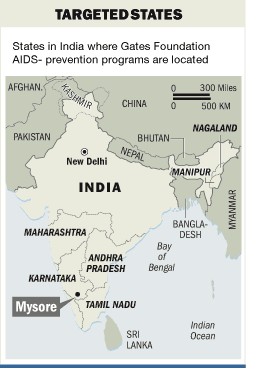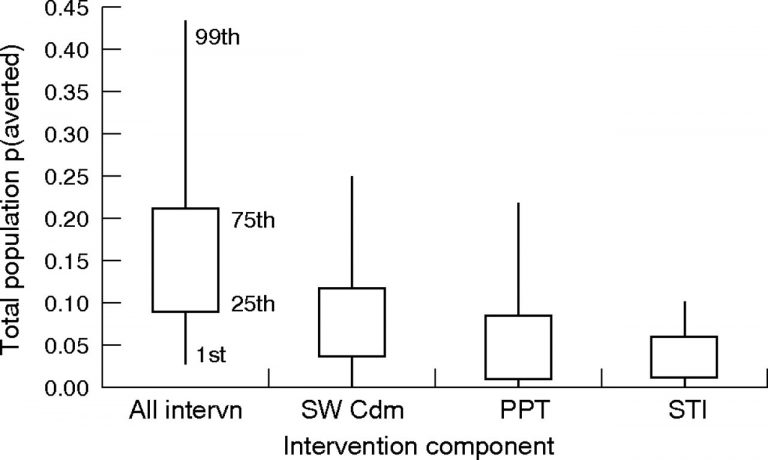Introduction
The subject of this study is Avahan: India AIDS Initiative which is directly related to the 6th of the 8 millennium development goals: combating diseases like HIV/AIDS, malaria, and others; improving the development in the third world countries; striving for international partnership, and some others (Haines & Cassels, 2004). The project has been created to reach out to a large group of people who are at risk of contracting HIV/AIDS and to prevent the spreading of the new HIV infections.
The at-risk groups are homosexuals, commercial sex workers and their clients, intravenous drug users, long distance truckers, and others living at the edge of poverty (Wagstaff, 2004). Avahan is targeted to protect and inform 5 280 000 people in all the six states of India (Attaran, 2005), as well as to develop and introduce the infection prevention strategies. According to Rechel et al. (2004), this very project was chosen for research as the hopes for progress and achievements in this field are thought to be almost non-existent.

About the Project
This concept was born out of the concern about the rising prevalence of HIV/AIDS in India and was guided by three aims or objectives according to Wagstaff (2004). The objectives of this project are: to create a model of HIV prevention system; to adjust and introduce it within the territory of India; to involve other organizations in adoption of this model for their own needs in fighting HIV/AIDS; and to initiate and spread education concerning the scourge in India and the world as a whole (Feeny & Clarke, 2009). This project is primarily funded by the Bill and Melinda Gates Foundation with 258 million dollars which have been donated on health improving, poverty removing, and other supportive actions for the third world countries (Rechel et al., 2004). Starting from 2009, they have invested additional 80 million dollars into the project so that it can develop well enough to integrate seamlessly with the AIDS project for the same purposes in 2013 or 2014 that is run by the government (Marshall & Marsh, 2003).
In course of the project, various players have been involved to provide various services for the benefit of reaching the global target. Most of those, according to Feeny and Clarke (2009), are involved in implementing preventive measures among the groups that are at high risk of contracting HIV/AIDS and the new forms of this terrible disease. The members of the project, notwithstanding the India National AIDS Control Organization and the Indian Government that take integral part in combating the disease and preventing the infection rate, are Emmanuel Hospital Association and Australian International Health Institute, Family Health International (FHI), Hindustan Latex Family Planning Promotion Trust (HLFPPT), International HIV/AIDS Alliance (IHAA), Pathfinder International, Tamil Nadu AIDS Initiative (TAI), University of Manitoba, Population Services International (PSI), Transport Corporation of India Foundation (TCIF), American India Foundation (AIF), BBC World Service Trust (BBC WST), Care International, and Center for Advocacy and Research (CFAR) among many others (Wagstaff, 2004).
Due to the nature of the project, the other individuals who are not a part of this group but who will benefit from the project are the dwellers of all the six states where the project is taking place (Wagstaff, 2004). Young women and men, regardless of sexual orientation, education, social and economic status will avail from the prevention strategies that are being implemented as a part of this project. The effectiveness of Avahan (India AIDS Initiative) will be felt as the years go by and, according to Haines and Cassels (2004), the situation will improve from generation to generation. The other groups of the project will help include the inhabitants of the countries or regions where this model for prevention of HIV infection will be replicated (Feeny & Clarke, 2009).
Analysis
There has been a decrease in the reports of harassment and discrimination of HIV-positive people by the police representatives and health care workers and now they are treated more or less like other citizens (Rechel et al., 2004). Peer network is the most effective part of the project as they are in constant contact with the target groups, they distribute up to 8 million free condoms a month which has been markedly higher than in previous years (Wagstaff, 2004), they also inform the target groups of the possible consequences of the infection spread. This has been attributed to removal of structural barriers, peer counselors, and the kind of interventions that have been instituted (Feeny & Clarke, 2009).

As a result of the program, sufficient and capable infrastructure has been implemented in the six states for the purpose of decreasing the risk of catching HIV infection among the high risk classes: long distance truckers and their fellow workers, men who have sex with men, commercial sex workers and their clients, as well as people that are generally at a high risk of contracting the disease (Haines & Cassels, 2004).

One of the peer counselors’ tasks is to collect field data of the effectiveness by their monitoring and evaluating actions, as well as reporting of the project disadvantages thereof the HIV/AIDS educational program. This is done in order to track and improve the progress of the project (Wagstaff, 2004). They are well trained and equipped to educate people from all social layers concerning HIV/AIDS infection (Marshall & Marsh, 2003). Most of their teaching aids are pictorial and are therefore easy to understand even for uneducated people (Feeny & Clarke, 2009). According to Rechel et al. (2004), the subjects which they cover during the HIV/AIDS education course are: self-esteem and personal development, negotiation and facilitation, advocacy, leadership, peer monitoring, etc.
The Avahan has attempted to remove most barriers that prevent the development of the similar programs in the world and achieve the global target (Haines & Cassels, 2004). The program has been at the forefront in advocating for the changes in laws and regulations which make the legal and social scene unsuitable for the preventive services (Rechel et al., 2004). There can be found strong support empowerment of individuals, free healthcare opportunities, food security, and anti violence moves in the states within which the program operates (Feeny & Clarke, 2009). All the methods are done in relation to the fact that everyone staying on the territory of India are at high risk of catching the disease.
In India, HIV/AIDS infection is associated with promiscuity and perversion by a person and, therefore, comes with a certain amount of stigma (Haines & Cassels, 2004). Circulators of the disease face discrimination and insult actions, murders, denials of families, communities, the police, and even health care workers (Feeny & Clarke, 2009). Thus, it is quite difficult for circulators to access healthcare and their children may even be deprived of an opportunity to study at school and get education like their peers (Attaran, 2005). The funding organization, the Bill and Melinda Gates Foundation has very little influence on the project itself, but is funding it nevertheless (Attaran, 2005). At the beginning, the project was claimed to be a waste of money but that did not discourage its donators (Haines & Cassels, 2004). According to Rechel et al. (2004), all the donated investment assets of the Foundation are distributed among the targets by the trustees and, therefore, the programs that benefit from the Foundation are able to function with little interference. The Foundation does not dictate the goals and objectives to the organizations benefiting from its financial support, neither does it direct the way these goals and objectives are achieved (Marshall & Marsh, 2003).
The project seriously considered the social and cultural context for the population that was targeted by this program. The target groups are discriminated and expelled from society for various reasons, one of which being the fact that they are infected with HIV (Wagstaff, 2004). Such behavior is common for the community in general and the family members, authorities, and health care personnel, in particular (Haines & Cassels, 2004).
This project has largely been successful as a result of the flexibility that was allowed to the programs launched within the project (Marshall & Marsh, 2003). Their workers are trained well but room is left for improvisation in case of unpredictable situations (Feeny & Clarke, 2009). The project has been modeled and implemented for the purpose of the Indian people and has been tailored to fit their specific needs which aid the success of the project as a whole (Haines & Cassels, 2004).
The project is sustainable and there is a lot of evidence that suggests it will exist for years to come (Haines & Cassels, 2004). The greatest evidence for this is that committed and zealous people who strive for the project and other government programs to succeed are ready to join in to receive funding that will not be forthcoming from the Foundation after 2014 (Feeny & Clarke, 2009).
Conclusion
In conclusion, this project may be improved by expanding it to reach other members of the Indian community. In fact, those at-risk groups are not the only problems of the third world country. However, this project has brought a lot of changes into the groups it targeted (Rechel et al., 2004). The fact that the police representatives and health care workers have changed their attitude towards HIV/AIDS carriers is an indication that the society has undergone a significant change itself (Attaran, 2005). This project strongly reflects the objectives of the 6th millennium development goal which is very important for improving the situation in the third world countries (Feeny & Clarke, 2009).
References
Attaran, M. (2005). An Immeasurable Crisis? A Criticism of the Millennium Development Goals and Why They Cannot Be Measured. PLoS Medicine, 2 (10), 318.
Feeny, S. & Clarke, M. (2009). The Millennium Development Goals and Beyond: International Assistance to the Asia-Pacific (Rethinking International Development). New York, NY: Palgrave Macmillan.
Haines, A., & Cassels, A. (2004). Can the Millennium Development Goals Be Attained? British Medical Journal, 329(7462), 394-397.
Marshall, K., & Marsh, R. (Eds.) (2003). Millennium Challenges for Faith Development and Faith Institutions. Washington, DC: World Bank.
Rechel, B., Shapo, L., & McKee, M. (2004). Millennium Development Goals for Health in Europe and Central Asia: Relevance and Policy Implications. Washington, DC: World Bank.
Wagstaff, A. (2004). Rising to the Challenges. Washington, DC: World Bank.